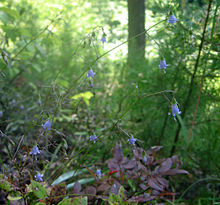
Campanula is one of several genera of flowering plants in the family Campanulaceae with the common name bellflower. It takes both its common and its scientific name from its bell-shaped flowers—campanula is Latin for "little bell".

The family Campanulaceae, of the order Asterales, contains nearly 2400 species in 84 genera of herbaceous plants, shrubs, and rarely small trees, often with milky sap. Among them are several familiar garden plants belonging to the genera Campanula (bellflower), Lobelia, and Platycodon (balloonflower). Campanula rapunculus and Codonopsis lanceolata are eaten as vegetables. Lobelia inflata, L. siphilitica and L. tupa and others have been used as medicinal plants. Campanula rapunculoides may be a troublesome weed, particularly in gardens, while Legousia spp. may occur in arable fields.

Campanula americana, the American bellflower, is a tall bellflower native to eastern North America from the Great Lakes region south to Florida and from the Dakotas east to New York. This native plant is an annual or biennial from 2-6' tall. Some authorities, including the USDA PLANTS database, consider the name Campanulastrum americanum to be the accepted name for this species.
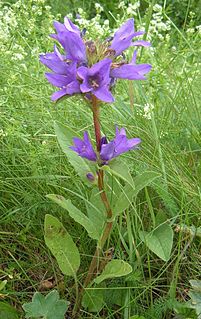
Campanula glomerata, known by the common names clustered bellflower or Dane's blood, is a species of flowering plant in the genus Campanula, belonging to the family Campanulaceae. It is the county flower of Rutland, England.
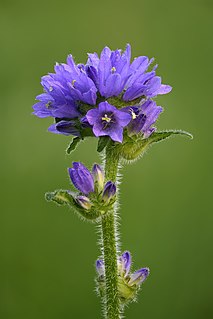
Campanula cervicaria, the bristly bellflower, is a species of flowering plant in the bellflower family Campanulaceae. The plant is roughly hairy and the flowers are about 1–2 centimetres (0.4–0.8 in) long, light blue and are grouped together.

Campanula latifolia, the giant bellflower, is a species of bellflower in the family Campanulaceae. It is also known as the large campanula and the wide-leaved bellflower. It is native to Europe and western Asia and is widely grown as an ornamental plant.
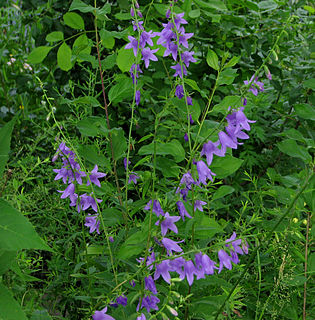
Campanula rapunculoides, known by the common names creeping bellflower, or rampion bellflower, is a perennial herbaceous plant of the genus Campanula, belonging to the family Campanulaceae.
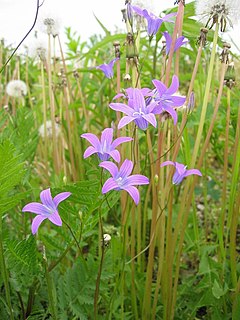
Campanula patula or spreading bellflower is a plant species of the genus Campanula. It can grow to more than half a meter high. This delicate bellflower bears lateral branches of pale blue or white flowers that are upright and funnel shaped. The leaves are narrow and pointed. Branches are often supported by the surrounding vegetation, so the plants can appear prostrate. The main difference between this and other bellflowers is that the petals in the bell are spread out and more pointed and this gives this species its common name.

Campanula scouleri is a species of bellflower known by the common names pale bellflower and Scouler's harebell. It is native to the mountains of western North America from northern California to Alaska. It is a rhizomatous perennial herb producing an erect or leaning stem 20 to 30 centimeters long. The leaves are thin to leathery, lance-shaped to round, and generally toothed, measuring 1 to 6 centimeters long and borne on short winged petioles. The pale blue bell-shaped flower has a strongly reflexed corolla with lobes curling back and sometimes almost touching. The style protrudes far from the center of the flower; it is blue in color and up to 1.5 centimeters long.

Campanula portenschlagiana, the wall bellflower, is a species of flowering plant in the family Campanulaceae, native to the Dalmatian Mountains in Croatia. It is a vigorous, low-growing, mound-forming evergreen perennial with deep purple flowers in summer. Other common names include Dalmatian bellflower, Adria bellflower.

Campanula alliariifolia is a species of flowering plant in the bellflower family Campanulaceae. It is native to the Caucasus and Turkey and it is grown as an ornamental plant. Common names include Cornish bellflower.

Campanula uniflora, known commonly as arctic bellflower and arctic harebell, is a short and slender rhizomatous perennial in the bellflower family Campanulaceae. It is distributed in arctic North America, including the Rocky Mountains and Greenland, in the Asian part of Beringia and in Iceland, Svalbard, the Scandes Mountains and Novaja Zemlja.

Favratia zoysii, known commonly as Zois' bellflower, Zoysi's harebell, or crimped bellflower, is the sole member of the genus Favratia, closely related to Campanula (bellflowers).

Campanula piperi is a species of flowering plant in the bellflower family, Campanulaceae. It is native to the Olympic Mountains on the Olympic Peninsula in the U.S. state of Washington. It has also been noted on Vancouver Island, British Columbia.

Campanula lasiocarpa, also known as the mountain harebell or Alaska harebell, is a plant native to the northwestern portion of North America including the US states of Alaska and Washington, as well as the Canadian provinces of Alberta, British Columbia, the Northwest Territories, and the Yukon. It is a member of the genus Campanula, commonly known as bellflowers. The blossoms of these flowers taste like a mixture of dandelion stems and the way honeysuckle smells, but no other purple flowers growing in the Yukon Territory should be consumed as most others range from somewhat poisonous to grotesquely perilous if eaten.

Campanula collina, common name blue dwarf bellflower, is a species of flowering plant in the bellflower family Campanulaceae, native to the Caucasus and north-eastern Turkey.

Campanula tommasiniana, also known as the Croatian Bellflower, is a perennial species of flowering plant in the family Campanulaceae. It is native to the alpine regions of Croatia.
